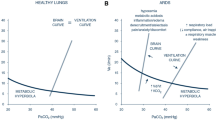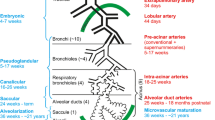Abstract
A comprehensive model of oxygen (O2) and carbon dioxide (CO2) exchange, transport, and storage in the adult human is presented, and its ability to provide realistic responses under different physiological conditions is evaluated. The model comprises three compartments (i.e., lung, body tissue, and brain tissue) and incorporates a controller that adjusts alveolar ventilation and cardiac output dynamically integrating stimuli coming from peripheral and central chemoreceptors. A new realistic CO2 dissociation curve based on a two-buffer model of acid-base chemical regulation is included. In addition, the model explicitly considers relevant physiological factors such as buffer base, the nonlinear interaction between the O2 and CO2 chemoreceptor responses, pulmonary shunt, dead space, variable time delays, and Bohr and Haldane effects. Model simulations provide results consistent with both dynamic and steady-state responses measured in subjects undergoing inhalation of high CO2 (hypercapnia) or low O2 (hypoxia) and subsequent recovery. An analysis of the results indicates that the proposed model fits the experimental data of ventilation and gas partial pressures as some meaningful simulators now available and in a very large range of gas intake fractions. Moreover, it also provides values of blood concentrations of CO2, HCO− 3, and hydrogen ions in good agreement with more complex simulators characterized by an implicit formulation of the CO2 dissociation curve. In the experimental conditions analyzed, the model seems to represent a single theoretical framework able to appropriately describe the different phenomena involved in the control of respiration.
Similar content being viewed by others
References
Bellville, J. W., B. J. Whipp, R. D. Kaufman, G. D. Swanson, K. A. Aqleh, and D. M. Wiberg. Central and peripheral chemoreflex loop gain in normal and carotid body-resected subjects.J. Appl. Physiol. 46: 843–853, 1979.
Brackett, N. C., J. J. Cohen, and W. B. Schwartz. Carbon dioxide titration curve of normal man.N. Engl. J. Med. 272:6–12, 1965.
Chiari, L., G. Avanzolini, F. Grandi, and G. Gnudi, A simple model of the chemical regulation of acid-base balance in blood. In: Engineering advances: new opportunities for biomedical engineers—Proceedings of the 16th Int. Conf. IEEE-EMBS, edited by N. Sheppard, M. Eden, and G. Kantor. Piscataway, NJ: The Institute of Electrical and Electronics Engineers, Inc., 1994, pp. 1025–1026.
Dahan, A., M. J., van den Elsen, A. Berkenbosch, J. DeGoede, I. C. Olievier, J. W. van Kleef, and J. G. Bovill, Effects of subanesthetic halothane on the ventilatory responses to hypercapnia and acute hypoxia in healthy volunteers.Anesthesiology 80:727–738, 1994.
DeGoede, J., and A. Berkenbosch. Dynamic end-tidal forcing technique: modelling the ventilatory response to carbon dioxide. In: Modeling and parameter estimation in respiratory control, edited by M. C. K. Khoo, New York: Plenum Press, 1989, pp. 59–69.
Easton, P. A., L. J., Slykerman, and n. R. Anthonisen. Ventilatory response to sustained hypoxia in normal adults.J. Appl. Physiol. 61:906–911, 1986.
Edelman, N. H., P. E. Epstein, S. Lahiri and N. S. Cherniack. Ventilatory responses to transient hypoxia and hypercapnia in man.Respir. Physiol. 17:302–314, 1973.
Ehefnawy, A., G. M. Saidel, and E. N. Bruce. CO2 control of the respiratory system: plant dynamics and stability analysis.Ann. Biomed. Eng. 16:445–461, 1988.
Fernandez, P. C., R. M. Cohen, and G. M. Feldman. The concept of bicarbonate distribution space: the crucial role of body buffers.Kidney Int. 36:747–752, 1989.
Fincham, W. F., and F. T. Tehrani. A mathematical model of the human respiratory system.J. Biomed. Eng. 5:125–133, 1983.
Fincham, W. F., and F. T. Tehrani. On the regulation of cardiac output and cerebral blood flow.J. Biomed. Eng. 5:73–75, 1983.
Gelfand, R. and C. J. Lambertsen. Dynamic respiratory response to abrupt change of inspired CO2 at normal and high PO2 J. Appl. Physiol. 35:903–913, 1973.
Gray, J. S. The multiple factor theory of the control of respiratory ventilation.Science 103:739–744, 1946.
Grodins, F. S., J. S. Gray, R. Schroeder, A. L. Norins, and R. W. Jones, Respiratory responses to CO2 inhalation. A theoretical study of a nonlinear biological regulator.J. Appl. Physiol. 7:283–308, 1954.
Grodins, F. S., J. Buell, and A. J. Bart. Mathematical analysis and digital simulation of the respiratory control system.J. Appl. Physiol. 22:260–276, 1967.
Ingram, D., C. J. Dickinson, and K. Ahmed. MACPUF Graphics Version. A Simulation of Human Respiration, Gas exchange and Control. Oxford: IRL Press Software, 1987.
Khamnei, S., and P. A. Robbins. Hypoxic depression of ventilation in humans: alternative models for the chemoreflexes.Respir. Physiol. 81: 117–134, 1990.
Levine, M., J.P. Cleave, and C. Dodds, Can periodic breathing have advantages for oxygenation?J. Theor. Biol. 172:355–368, 1995.
Loeppky, J. A., U. C. Luft, and E. R. Fletcher. Quantitative description of whole blood CO2 dissociation curve and Haldane effect.Respir. Physiol. 51: 167–181, 1983.
Loeppky, J. A., E. R. Fletcher, R. C. Roach, and U. C. Luft. Relationship between whole-blood base excess and CO2 content in vivo.Respir. Physiol. 94:109–120, 1993.
Longobardo, G. S., and N. S. Cherniack, Abnormalities in respiratory rhythm. In: Handbook of physiology. The respiratory system. Part II, edited by N. S. Cherniack and J. G. Widdicombe. Bethesda: American Physiological Society, 1986, pp. 729–749.
The Math Works, Inc.: SIMULINK User's Guide. Natick, MA: 1992, 275 pp.
Nielsen, M., and H. Smith: Studies on the regulation of respiration in acute hypoxiaActa Physiol. Scand 24:293–313, 1952.
Otis, A. B., W. O. Fenn, and H., Rahn. Mechanics of breathing in man.J. Appl. Physiol. 2:592–607, 1950.
Painter, R., S. Khamnei, and P. Robbins. A mathematical model of the human ventilatory response to isocapnic hypoxia.J. Appl. Physiol. 74:2007–2015, 1993.
Piiper, J. Pulmonary and circulatory carbon dioxide transport and acid-base homeostasis. In: pH homeostasis. Mechanisms and control, edited by D. Häussinger, London: Academic Press, 1988, pp. 181–202.
Rebuck, A. S., A. S. Slutsky, and C. K. Mahutte, A mathematical expression to describe the ventilatory response to hypoxia and hypercapnia.Respir. Physiol 31:107–116 1977.
Reynolds, W. J., H. T. Milhorn, and G. H. Holloman. Transient ventilatory response to graded hypercapnia in man.J. Appl. Physiol. 33: 47–54, 1972.
Reynolds, W. J., and H. T. Milhorn. Transient ventilatory response to hypoxia with and without controlled alveolar PCO2.J. Appl. Physiol. 35:187–196, 1973.
Sharan, M., M. P. Singh, and A Aminataei. A mathematical model for the computation of the oxygen dissociation curve in human blood.Biosystems 22:249–260, 1989.
Siggaard-Andersen, O., and K. Engel. A new acid-base nomogram. An improved method for the calculation of the relevant blood acid-base data.Scand. J., Clin Lab. Invest. 12:177–186, 1960.
Takahashi, E. and K. Doi. Destabilization of the respiratory control by hypoxic ventilatory depressions: a model analysis.Jpn. J. Physiol. 43:599–612, 1993.
Ward, D. S., and J. W. Bellville. Effect of intravenous dopamine on hypercapnic ventilatory response in humans.J. Appl. Physiol. 55:1418–1425, 1983.
West, J. B., Respiratory Physiology: The Essentials, Baltimore: Williams & Wilkins, 1990, 185 pp.
Author information
Authors and Affiliations
Rights and permissions
About this article
Cite this article
Chiari, L., Avanzolini, G. & Ursino, M. A comprehensive simulator of the human respiratory system: Validation with experimental and simulated data. Ann Biomed Eng 25, 985–999 (1997). https://doi.org/10.1007/BF02684134
Received:
Revised:
Accepted:
Issue Date:
DOI: https://doi.org/10.1007/BF02684134




